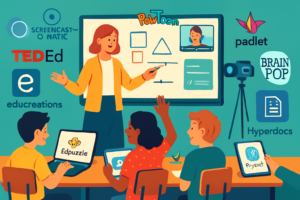
Hey teachers, please find Top 10 Flipped Classroom Tools for Teachers!
A flipped classroom is a teaching approach where students first learn new material at home, typically through videos or digital resources, and use classroom time for interactive activities, discussions, and problem solving.
Adopting the flipped classroom model can transform how educators deliver content, promote engagement, and foster deeper learning in students.
Rather than relying solely on direct instruction during class, the flipped classroom approach lets students first encounter new concepts through videos, tutorials, or interactive presentations at home, so valuable classroom time can be devoted to hands on activities, problem solving, and collaborative discussions.
To implement this approach successfully, educators need quality digital tools that enable the creation, sharing, and monitoring of learning materials.
Here’s an in-depth look at the top 10 flipped classroom tools every teacher should know about.
1. EdPuzzle
EdPuzzle empowers teachers to adapt virtually any video—be it from YouTube, Khan Academy, or their own recordings into an interactive lesson.
Teachers can embed questions, commentary, or quizzes at specific points in a video, ensuring students are actively participating and comprehending critical moments.
EdPuzzle’s analytics feature provides insight into student engagement, such as who watched the video and how they responded, allowing for data-driven instruction.
2. Screencast-o-matic
This intuitive screen recorder is a favorite among educators for its ease of use and versatility. Instructors can create screencasts to explain lessons, solve problems, or provide assignment walk-throughs.
Videos can be annotated, trimmed, and enhanced with voice narration.
These presentations can be shared directly with students for self-paced learning, ensuring students can revisit complex concepts as often as necessary.
3. PowToon
With PowToon, teachers can design visually captivating animated videos and presentations.
This tool excels at distilling dense information into digestible, engaging content, making it particularly useful for explaining abstract concepts or providing lesson previews.
Coupled with templates and drag-and-drop functionality, PowToon enables teachers without advanced tech skills to create professional-quality resources.
4. TEDEd
TEDEd leverages a vast video library and allows teachers to build custom interactive lessons around educational videos from TED, YouTube, or even their own channels.
Lessons can include discussion questions, supplemental resources, and quizzes, making it easy to spark curiosity and foster critical thinking before class.
This platform also encourages students to revisit or extend learning with related digital resources.
5. Nearpod
Nearpod stands out for its ability to create interactive multimedia lessons enriched with quizzes, polls, simulations, and open-ended questions.
Teachers can monitor student progress in real time and adapt instruction on the fly.
Sessions can be synchronous or asynchronous, and the platform accommodates both in-person and remote flipped classrooms, making it highly flexible for different teaching styles.
6. Padlet
Padlet allows students to record and post video responses directly onto a shared board. While it lacks Flipgrid’s camera filters and add-ons, its simplicity and ease of use make it a favorite.
Students can record up to 2 minutes, review, and resubmit video responses. They can also comment on classmates’ work using text or video, closely mimicking Flipgrid’s core experience
7. Educreations
Providing a digital whiteboard, Educreations enables teachers to record lessons while drawing, writing, and narrating their thinking.
These interactive lessons can easily be shared with students, who benefit from seeing not just the “what” but the “how” behind a problem-solving process.
Educreations is especially useful for math, science, and other visually-driven subjects.
8. Camtasia
Camtasia is a robust video creation and editing suite, perfect for teachers who want to make high-quality, polished instructional videos.
The software offers advanced features such as multi-track editing, visual effects, overlays, and interactive quizzes.
While it requires a bit more investment and learning curve, Camtasia is an excellent tool for creating content that stands out and remains reusable year after year.
9. BrainPOP
BrainPOP‘s animated videos, games, and quizzes make complex topics accessible and fun.
Teachers can assign specific videos as pre-class homework, and follow up with assessments or interactive activities in class.
BrainPOP’s curriculum aligned content spans science, math, social studies, English, and more, supporting diverse classroom needs.
10. Hyperdocs
Hyperdocs is not just a tool, but a teaching strategy powered by digital documents. Teachers curate instructional resources, videos, readings, assignments, and interactive tasks into a single, well-structured document.
Students can work independently or collaboratively, moving through engaging, personalized learning journeys at their own pace.
Hyperdocs streamline flipped classroom management and are adaptable to any content area.
Integrating these Flipped Classroom tools can breathe new life into the classroom experience.
By shifting direct instruction outside of class and using technology to support self-paced, active, and collaborative learning, teachers empower students to become independent thinkers and problem solvers, ready to thrive in today’s dynamic world.


